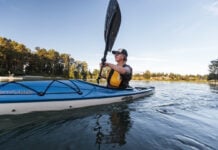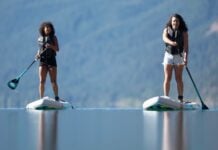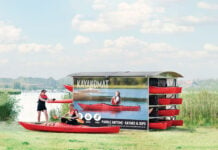Nineteen eighty-one was the dim pre-dawn of sea kayaking’s boom times. Just around the corner were the first coastal symposia, cheap plastic touring kayaks and sea kayaking magazines. Baby boomers settled into careers that paid for kayaks but clung to the hippie sensibilities that motivated them to keep taking their vacations in the wilderness. A couple decades of double-digit growth transformed kayaks on the roof rack from head-turners to ho-hum.
The year 1981 also marked the release of one of the original sea kayaking instructional books, John Dowd’s Sea Kayaking: The Classic Manual for Touring, from Day Trips to Major Expeditions. Thirty-four years and 60,000 copies later, in the introduction to the book’s sixth addition, Dowd laments the trends that have accompanied the sport’s recent reversal of fortune.
 Sea Kayaking: The Classic Manual for Touring, from Day Trips to Major Expeditions
Sea Kayaking: The Classic Manual for Touring, from Day Trips to Major Expeditions
Still regarded as “the bible” for both new and experienced kayakers after more than thirty years in print, Sea Kayaking covers the basics of equipment and technique, including types of paddles and strokes, as well as such essential skills as how to read the weather and the water, how to navigate with and without GPS and how to travel with a group. Drawing on his many years of experience paddling in all climates, John Dowd presents practical advice on dealing with potential hazards (from surf to sea ice to sharks), carrying out rescues and planning for long-distance expeditions.
Dowd had a unique perspective on kayaking during the early 2000s. For a decade he and his wife Bea lived off the grid in a cedar-shake cabin on a surf- swept beach in Clayoquot Sound, a popular kayaking destination. At first the Dowds routinely saw 30 or 40 kayakers at a time camping on “their” beach—my wife and I were once among them. Ten years later, the only visitors on a long weekend were some campers dropped off by water taxi.
“It wasn’t a sudden shift,” he writes. “More and more we’d been seeing groups of wannabe guides, kayak instructors-in-training and occasional school parties replace the private groups…. An increasing focus on standards and certifications had already begun to change the nature of the sport from an escapist activity for adventurers to a regulated activity for recreational groups and clubs, but something else was surely going on.”
Indeed, a lot has changed. Dowd’s Clayoquot tenure saw the onslaught of the iPhone and the Great Recession. Times are tougher now and we’re all working two jobs to pay for granite countertops and smartphone data plans for the whole family. Boomers are getting too old to sleep on the ground. And personally, when I landed on Dowd’s beach my wife was pregnant and seasick; today, that baby is six years old and a lot harder to pack—ditto for her little brother. The next time we went to Tofino we skipped the kayaking and booked a hotel near town.
Apparently, we aren’t the only ones. According to Dowd, people are still buying kayaks for day trips, but sales of full-length touring kayaks are down by 50 percent.
Still, Dowd suggests that along with these social factors, his experiences demonstrate how the “bureaucratization of sea kayaking” is at least part of what snuffed out its popularity. He posits that the push to professionalization in the kayaking industry has been a step backward for a sport whose greatest appeal is the simple escape that it offers from an increasingly risk-averse and programmed world.
I learned to kayak exactly 20 years ago by walking into a shop and buying one of the boats hanging from the ceiling. Soon I was flailing around in storm waves at the beach, practicing clumsy paddle float self-rescues I’d read about in books like Dowd’s. My discomfort on timid forays into the ocean’s unfamiliar waves and currents quickly taught me how much I had yet to learn.
I felt my own way forward, building up to multi-day trips on the open coast, rolling, surfing tidal rapids, an 80-day expedition, working at this kayaking magazine. Then, overnight, it seemed that every advanced paddler I met was some kind of guide or instructor. They’d ask me about my level of certification and I wouldn’t know what to say.
The same phenomenon of credential overproduction has befallen society as a whole. The world is now so full of highly educated people looking for somewhere to sell their expensive knowledge that it’s hard to break into just about any field, even with an advanced degree. It befits those who hold the credentials to convince everybody else that they’re necessary. But—take it from me, a guy with a master’s degree in outdoor recreation and a post-grad diploma in journalism who went on to write stories about kayaking—we don’t have to believe the hype.
“I foresee a time when you will need to be certified in order to buy or rent a kayak.”
This phenomenon spills over to everyday life, where it seems you can’t do anything without expert advice. Most of the people I see working out at the gym are under the direct supervision of a personal trainer with a string of initials after his name. There are professional coaches for everything: organization, nutrition, wellness, even life itself. Last time our kids were being brats, my wife insisted we needed a parenting coach.
“What did the cavemen do?” I retorted. Somehow traditional societies managed to raise their own successful, well-adjusted children without experts. They also invented kayaking.
Nowadays, society discourages us from thinking for ourselves and taking risks, and we’ve infected our kids with the same paranoia. Some say this helicopter parenting is producing a generation of pathologically anxious and dependent young adults.
It used to be that youth were the ones with the time to go on crazy long wilderness expeditions. Now, kayak touring appears too scary for the only generation with the time to do it. Besides, they’re all too busy paying off the student loans for the PhDs on their Starbucks resumes.
In my youth, people learned to do things for themselves because the world was not so populated with experts and coaches. If you wanted to learn to kayak, you just bought the gear and did it, sometimes with a detour to the library for a John Dowd book. If you needed company, you invited a friend. Once you figured it out, you became the expert. The roads to the wilderness were not paved. There were no tolls or gatekeepers. The camping was free. You could land on a remote beach and the guy who wrote the book would be there to welcome you to the club.
Today, we spend more time working so we can pay others to tell us how to spend our time off. Kayaking was supposed to take us away from all that.
“I foresee a time when you will need to be certified in order to buy or rent a kayak,” writes Dowd. So get out there and do some escapist adventuring while you still can. Listen to me, your kayaking life coach, before I start billing by the hour.
Tim Shuff is a firefighter, freelance writer and former editor of Adventure Kayak who realized he’d hit middle age when he found himself writing the phrases “in my youth” and “kids these days.”
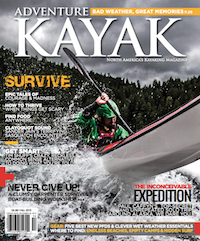
Subscribe to Paddling Magazine and get 25 years of digital magazine archives including our legacy titles: Rapid, Adventure Kayak and Canoeroots.


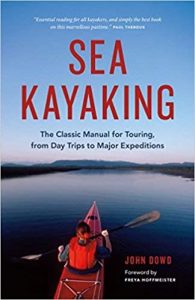 Sea Kayaking: The Classic Manual for Touring, from Day Trips to Major Expeditions
Sea Kayaking: The Classic Manual for Touring, from Day Trips to Major Expeditions